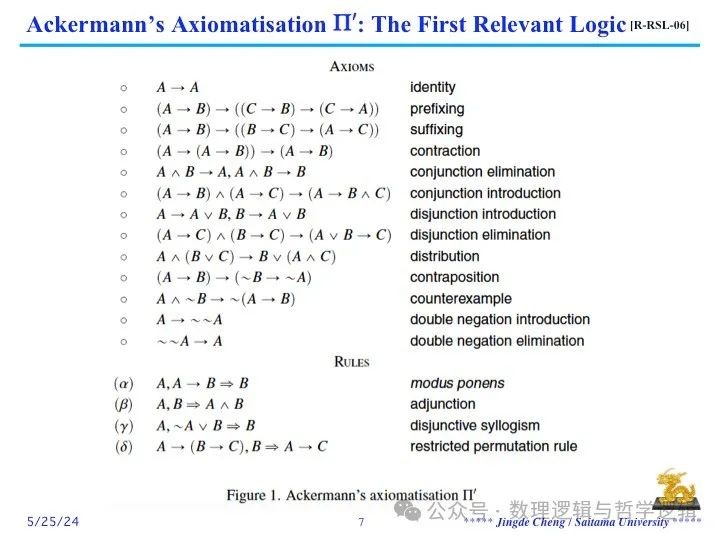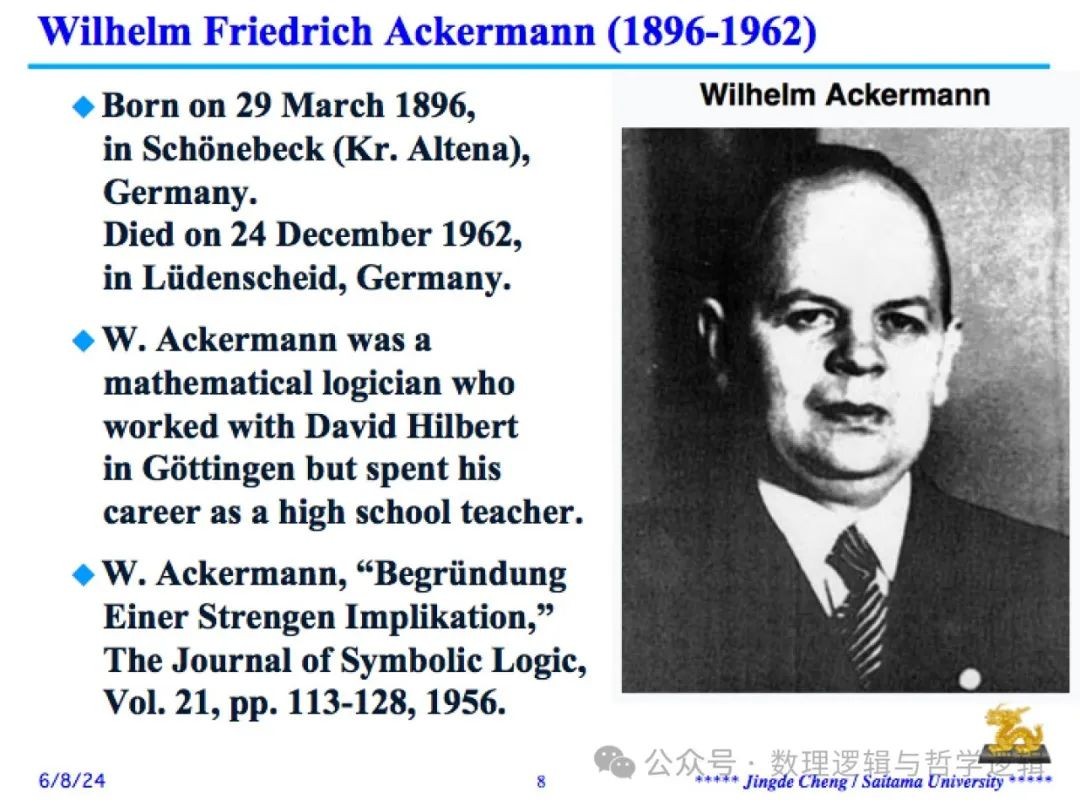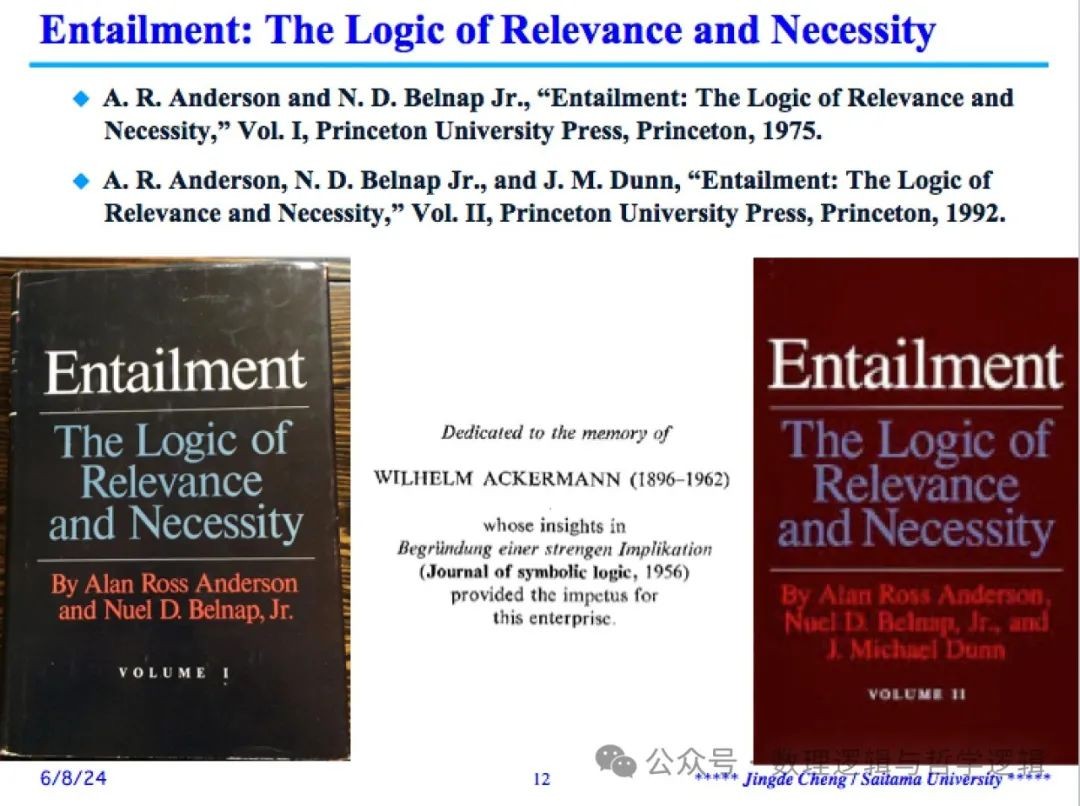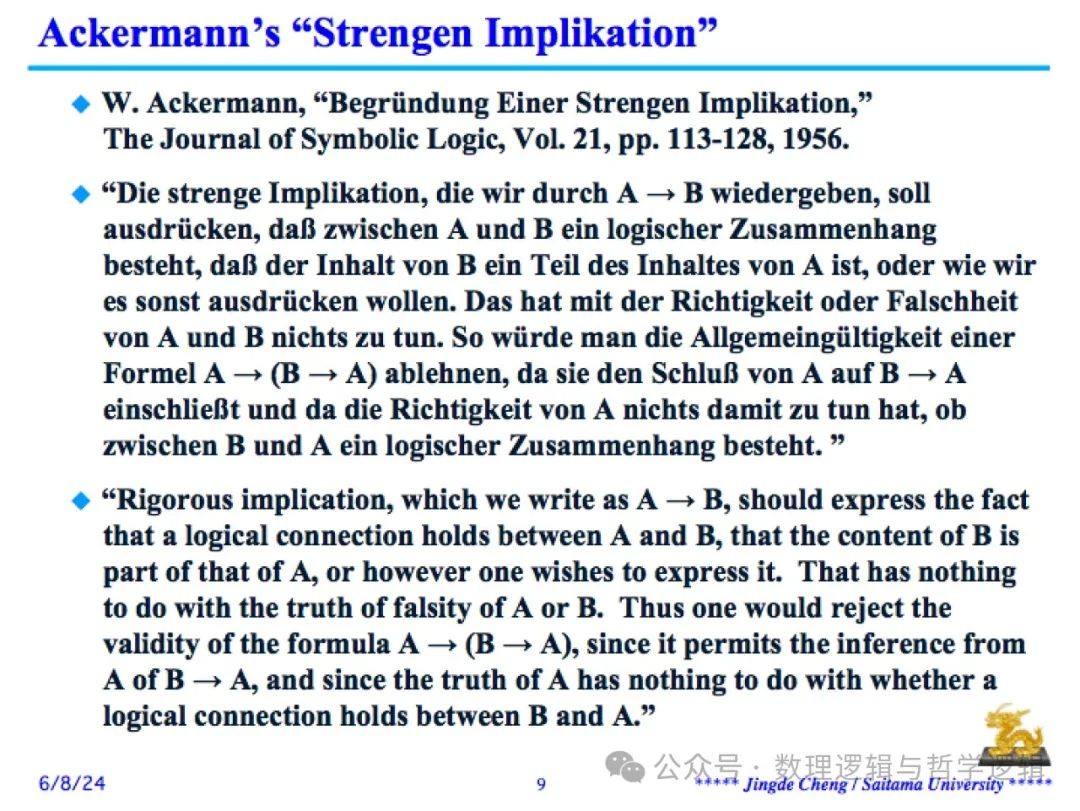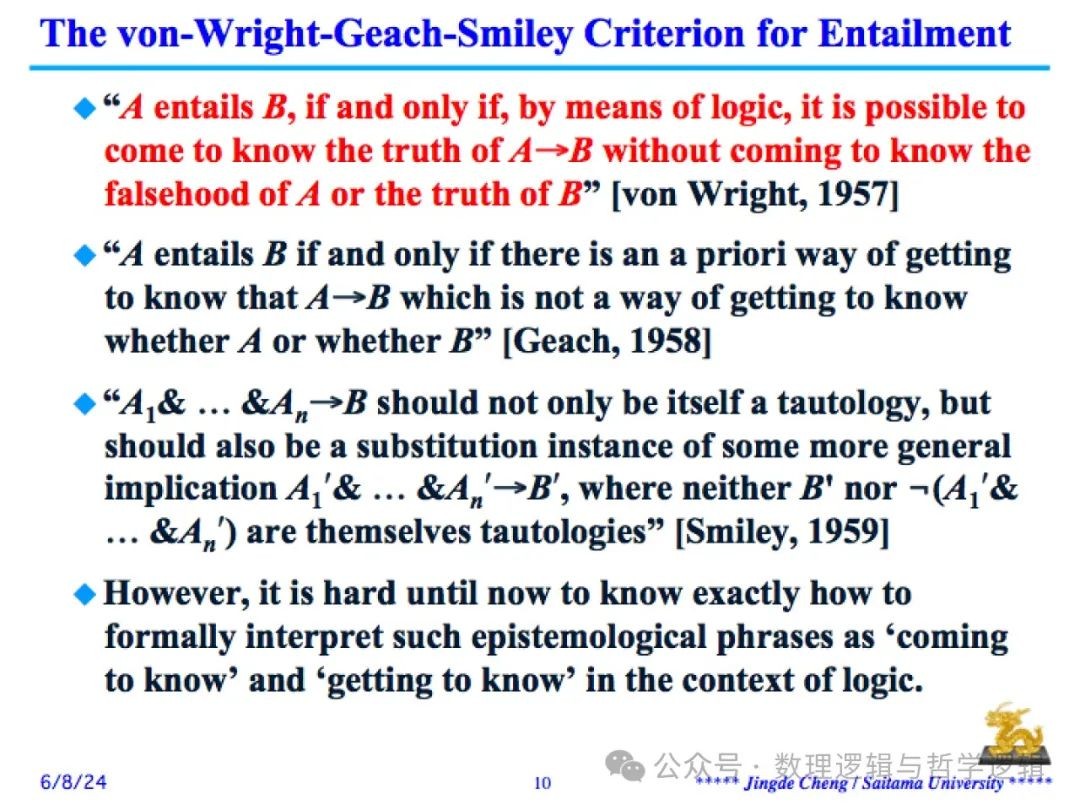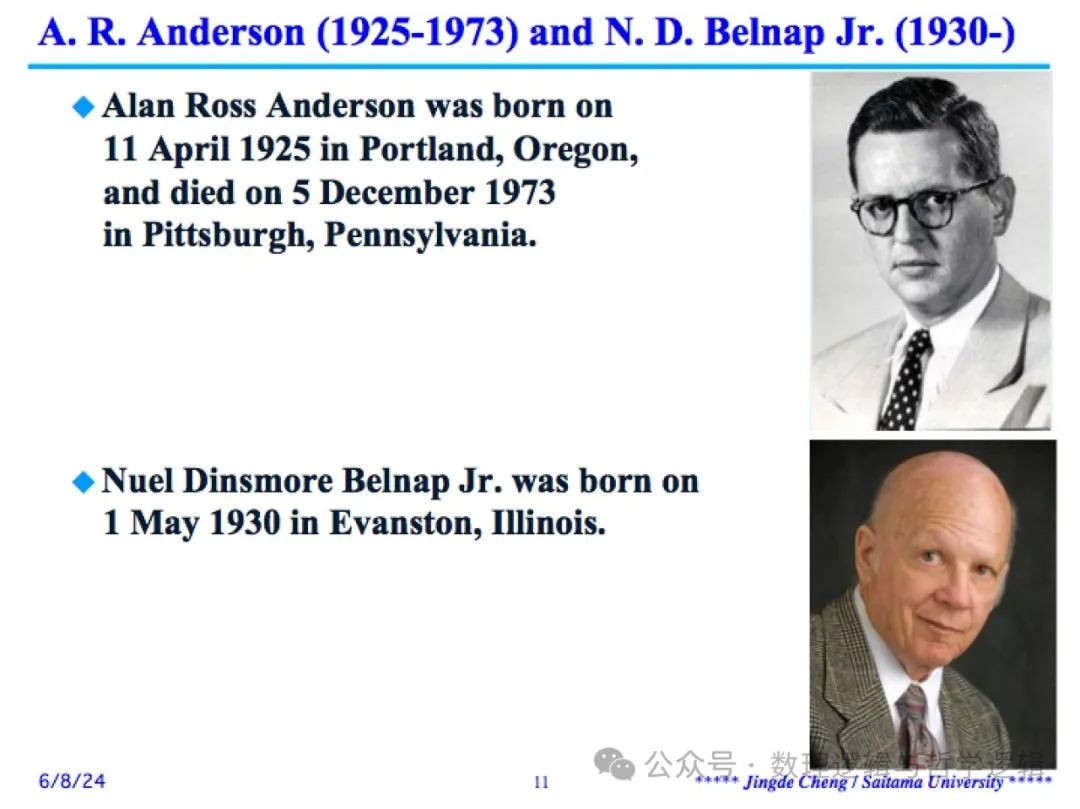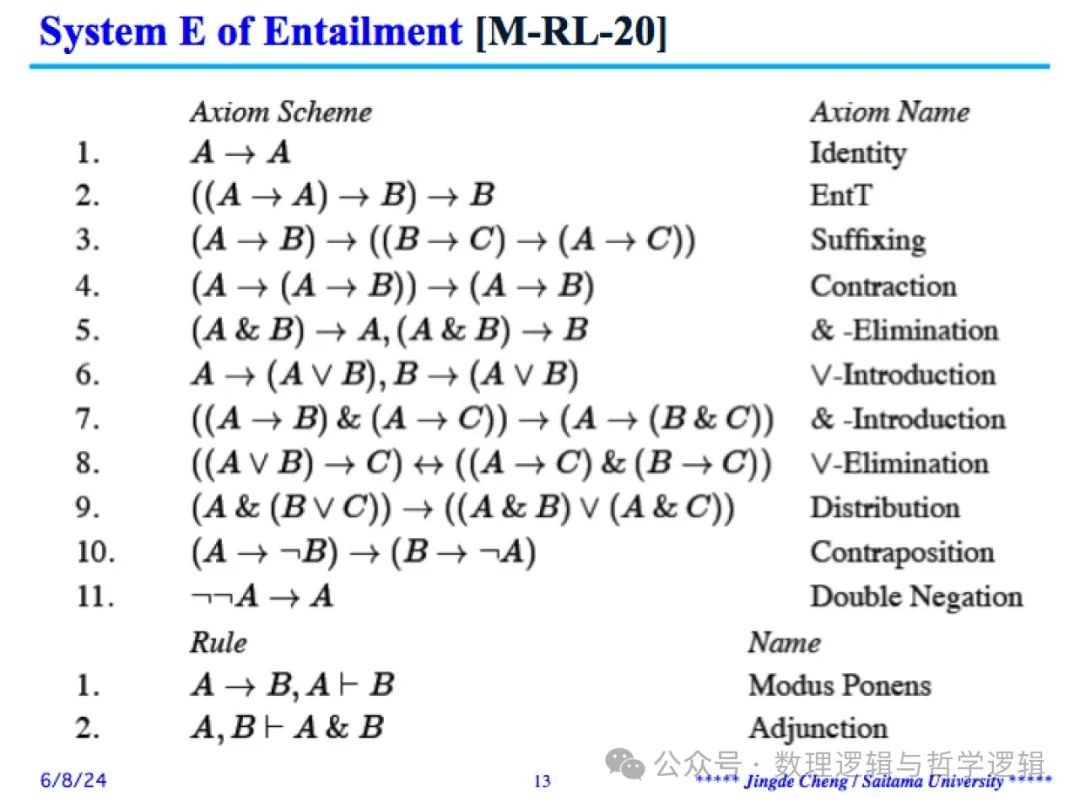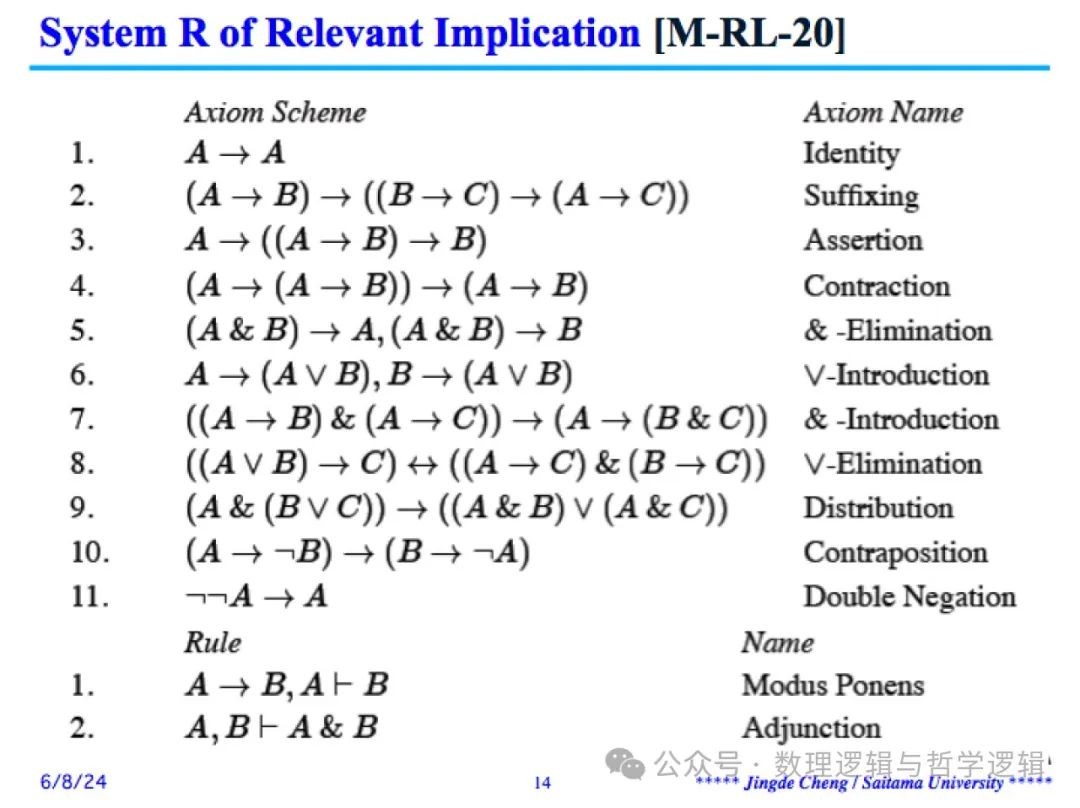博文
相关逻辑 (2) - 创建
 精选
精选
||
[敬请读者注意] 本人保留本文的全部著作权利。如果哪位读者使用本文所描述内容,请务必如实引用并明白注明本文出处。如果本人发现任何人擅自使用本文任何部分内容而不明白注明出处,恕本人在网上广泛公布侵权者姓名。敬请各位读者注意,谢谢!
相关逻辑 (2) - 创建
程京德
自20世纪50年代起至今,相关逻辑(Relevant/Relevance Logic)已经发展成为哲学逻辑中一个非常重要的分支。笔者主张,相关逻辑必将成为支撑智能科学及人工智能技术的统一理论之逻辑基础。本系列文章将全面介绍相关逻辑及其应用。
相关逻辑之创建
德国逻辑学家阿克曼(Wilhelm Friedrich Ackermann, 1896-1962)是相关逻辑的创始者 [1-19]。
阿克曼于1956年在“The Journal of Symbolic Logic”上发表了题为“Begründung Einer Strengen Implikation,”的论文[1],提出了用一个初始内涵逻辑联结词“Strengen Implikation (Rigorous Implication,严密蕴涵)”来表达和刻画条件句概念/蕴涵关系的划时代重要思想,并提出了一个公理化逻辑系统(第一个完整的相关逻辑系统)π’来刻画“严密蕴涵”(以及其它逻辑联结词)的性质/行为,π’从其逻辑定理中成功地完全排除了(经典数理逻辑的)实质蕴涵悖论和(刘易斯模态逻辑的)严格蕴涵悖论 [3-19]。“他的 Strengen Implikation 的系统的主要优点之一是,它和它的近邻系统第一次给了我们一个理解“如果…那么--”命题中前件与后件之间难以捉摸的相关性的、在数学上令人满意的方法。(one of the principal merits of his system of strengen Implikation is that it, and its neighbors, give us for the first time a mathematically satisfactory way of grasping the elusive notion of relevance of antecedent to consequent in “if … then --” propositions)”[3]。相关逻辑创建时期研究成果之集大成、两卷本“Entailment: The Logic of Relevance and Necessity”[3,4]就是献给阿克曼以纪念其创建相关逻辑之功绩的。
关于初始内涵逻辑联结词“严密蕴涵(Strengen Implikation, rigorous implication)”(在本文中用“=>”来表达),阿克曼说到:“严密蕴涵,我们写为“A=>B”,应该表达这样一个事实: 在 A 和 B 之间存在有一种逻辑联系,B的内容是 A 的内容的一部分,或者人们希望如此。这与 A 或 B 的真假无关。因此,人们会拒绝逻辑式 A=>(B=>A) 的有效性,因为它允许从 A 推出 B=>A,而 A 的真值与 B 和 A 之间是否存在有逻辑联系完全无关。(Die strenge Implikation, die wir durch A → B wiedergeben, soll ausdrücken, daß zwischen A und B ein logischer Zusammenhang besteht, daß der Inhalt von B ein Teil des Inhaltes von A ist, oder wie wir es sonst ausdrücken wollen. Das hat mit der Richtigkeit oder Falschheit von A und B nichts zu tun. So würde man die Allgemeingültigkeit einer Formel A → (B → A) ablehnen, da sie den Schluß von A auf B → A einschließt und da die Richtigkeit von A nichts damit zu tun hat, ob zwischen B und A ein logischer Zusammenhang besteht.)(Rigorous implication, which we write as A → B, should express the fact that a logical connection holds between A and B, that the content of B is part of that of A, or however one wishes to express it. That has nothing to do with the truth of falsity of A or B. Thus one would reject the validity of the formula A → (B → A), since it permits the inference from A of B → A, and since the truth of A has nothing to do with whether a logical connection holds between B and A.)”[1,12,18]。
阿克曼提出的用一个初始内涵逻辑联结词来表达条件句概念/蕴涵关系的的思想,之后又被 von Wright,Geach,Smiley 三位逻辑学家分别归纳和陈述,现在被称为“The von-Wright-Geach-Smiley criterion for entailment”,简称“WGS criterion”,是关于条件句表达的重要标准 [3,4]。
美国逻辑学家安德森(Alan Ross Anderson, 1925-1973)和贝尔纳普(Nuel Dinsmore Belnap, Jr., 1930- )以及他们的学生们从上世纪五十年代到七十年代在相关逻辑领域做了一系列的工作。他们提出了初始内涵逻辑联结词“必然归结(entailment)”的概念,并且将阿克曼的相关逻辑 π’重构为等价的相关逻辑系统“system E of entailment”,提出了初始内涵逻辑联结词“相关蕴涵(relevant implication)”的概念并构造了相关逻辑系统“system R of relevant implication”(以及其它一些相关逻辑系统)[3,4]。这些相关逻辑系统都从其逻辑定理中成功地完全排除了实质蕴涵悖论和严格蕴涵悖论 [3-19]。但是,这些相关逻辑系统并未从其逻辑定理中排除所有的蕴涵悖论,仍然遗留有“相关蕴涵悖论” [20-22]。
参考文献
[1] W. Ackermann, “Begründung Einer Strengen Implikation,” The Journal of Symbolic Logic, Vol. 21, pp. 113-128, 1956 (in German).
[2] D. Hilbert and W. Ackermann, “Grundzüge der Theoretischen Logik,” 1928(Erstens Auflage), 1938(2 Auflage), 1949(3 Auflage), 1959(4 Auflage) [Ackermann added a section about his work on relevant logic in the 4th edition of this book.], 1972(6 Auflage), Springer-Verlag (in German). English translation: “Principles of Mathematical Logic,” AMS Chelsea Publishing, 1950 (translation of the 1938 second edition). 中译:莫绍揆 译,“数理逻辑基础”(第三版),1958.
[3] A. R. Anderson and N. D. Belnap Jr., “Entailment: The Logic of Relevance and Necessity,” Vol. I, Princeton University Press, Princeton, 1975.
[4] A. R. Anderson, N. D. Belnap Jr., and J. M. Dunn, “Entailment: The Logic of Relevance and Necessity,” Vol. II, Princeton University Press, Princeton, 1992.
[5] G. Restall, “Relevant and Substructural Logics,” in D. M. Gabbay and J. Woods (Eds.), “Handbook of the History of Logic, Vol. 7: Logic and the Modalities in the Twentieth Century,” pp. 289-398, Elsevier B.V., Amsterdam, 2006.
[6] J. M. Dunn, “Relevance Logic and Entailment,” in D. Gabbay and F. Guenthner (eds.), “Handbook of Philosophical Logic,” Vol. III, pp. 117-224, D. Reidel, Dordrecht, 1986.
[7] J. M. Dunn and G. Restall, “Relevance Logic,” in D. Gabbay and F. Guenthner (Eds.), “Handbook of Philosophical Logic, 2nd Edition,” Vol. 6, pp. 1-128, Kluwer Academic, Dordrecht, 2002.
[8] M. R. Diaz, “Topics in the Logic of Relevance,” Philosophia Verlag, Munchen, 1981.
[9] R. Routley, V. Plumwood, R. K. Meyer, and R. T. Brady, “Relevant Logics and Their Rivals, Part I, The Basic Philosophical and Semantical Theory,” Ridgeview, Atascadero, California, 1982.
[10] R. Brady (Ed.), “Relevant Logics and Their Rivals, Volume II, A Continuation of the Work of Richard Sylvan, Robert Meyer, Val Plumwood, and Ross Brady,” Ashgate Publishing, Aldershot, 2003.
[11] J. Norman and R. Sylvan (Eds.), “Directions in Relevant Logic,” Kluwer Academic, Dordrecht, 1989.
[12] S. Read, “Relevant Logic: A Philosophical Examination of Inference,” Basil Blackwell, Oxford, 1988, 2012.
[13] E. D. Mares, “Relevant Logic: A Philosophical Interpretation,” Cambridge University Press, Cambridge, 2004.
[14] G. Priest, “An Introduction to Non-Classical Logic - From If to Is, Second Edition,” Part I Propositional Logic - Chapter 1 Classical Logic and the Material Conditional, Part I Propositional Logic - Chapter 10 Relevant Logics, Part II Quantification and Identity - Chapter 24 Relevant Logics, Cambridge University Press, Cambridge, 2008.
[15] E. D. Mares and R. K. Meyer, “Relevant Logics,” in L. Goble (Ed.), “The Blackwell Guide to Philosophical Logic,” pp. 280-308, Blackwell, Oxford, 2001.
[16] E. D. Mares, “Relevance Logic,” in D. Jacquette (Ed.), “A Companion to Philosophical Logic,” pp. 609-627, Blackwell, Oxford, 2002.
[17] K. Bimbo, “Relevance Logics,” in D. Jacquette (Ed.), “Philosophy of Logic,” pp. 723-789, Elsevier B. V., Amsterdam, 2007.
[18] A. Aberden and S. Read, “Philosophy of Alternative Logics,” in L. Haaparanta (Ed.), “The Development of Modern Logic,” Oxford University Press, Oxford, 2009.
[19] E. D. Mares, “Relevance Logic,” The Stanford Encyclopedia of Philosophy, Center for the Study of Language and Information (CSLI), Stanford University, 1998, 2020.
[20] 程京德,“相关推论与强相关逻辑”,科技导报,Vol. 34, No. 7, pp. 39-47, 2016.
[21] 程京德,“强相关逻辑及其应用(上)、(中)、(下)”,微信公众号“数理逻辑与哲学逻辑”,科学网博客,2023年6月18日、2023年8月8日、2023年8月12日。
[22] 程京德,“悖论集锦(2) – 作为逻辑学中最大难题的蕴涵悖论问题(上)”,微信公众号“数理逻辑与哲学逻辑”,科学网博客,2024年3月18日;悖论集锦(2) – 作为逻辑学中最大难题的蕴涵悖论问题(上)(修订增补版)”,微信公众号“数理逻辑与哲学逻辑”,2023年4月11日;“悖论集锦(2) - 作为逻辑学中最大难题的蕴涵悖论问题(下)”,微信公众号“数理逻辑与哲学逻辑”,科学网博客,2024年4月18日。
微信公众号“数理逻辑与哲学逻辑”
https://blog.sciencenet.cn/blog-2371919-1437402.html
上一篇:逻辑学家罗素谈“中国人的品格”,兼论AIGC工具的数据污染问题
下一篇:相关逻辑 (3) - 特征
